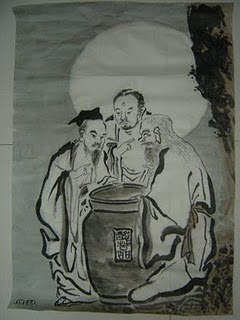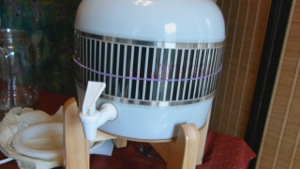Welcome to…
Chapter 2:
Secrets of
Kombucha Tea!
Remember your bonus vocab?
“Hey KT fans, how’s your day?”
(See how cool it sounds, “KT.” Like a secret password)

Genius Grady Booch looks like my dad. Coincidence?
How about another BONUS DEFINITION:
Booch = slang term for Kombucha
Now, remember the terms from yesterday?
- Nutrient Solution
- Starter Liquid
- SCOBY
Those are the components of our basic brewing equation:
Nutrient Solution + Starter Liquid + SCOBY + Time = Booch
Essentially, that is your recipe.
If you can make a pot of tea, then you can make Kombucha!
——————————
Let’s start with a little storytime…

The 3 Vinegar Tasters, Chinese legend, may very well be Kombucha’s origin story.
Where does Kombucha come from?
As the legend goes, Kombucha was invented in the Qin Dynasty (220 BC) for the Emperor, Qin Shi Huangdi. The Chinese are famed for their quest for all manner of longevity elixirs. From Kombucha to ginseng to snake’s blood, they have always looked to nature to cure what ails them.
From there it spread throughout Asia. Purportedly in 414 AD, a Korean Dr. Kombu brought this famous tonic to the Emperor Ingyō of Japan. Chá (茶) is the Chinese word for tea.
Kombu+cha = Kombucha.
Ancient Japanese warriors are said to have carried the tonic into battle, fermenting as they moved. Others write that a fermented, vinegary beverage filled the travel flasks of Genghis Khan and his armies.
In China, traditionally the grandmother cared for and cultivated the Kombucha using the ancient tradition of Continuous Brewing, passed down from mother to daughter. During the Cultural Revolution, every household had a pot of Kombucha brewing, and though it had once fallen out of the daily routine of the modern Chinese lifestyle, it is making a comeback.
 From Ancient China, Kombucha traveled via the Silk Road to Russia, where it is called kvass or čajnyj grib which means “mushroom tea.” It consequently spread to all of Europe where it was very popular until World War II, when rationing made sugar and tea hard find. It is still quite popular in Germany where it is known as teepilz, “tea fungus.”
From Ancient China, Kombucha traveled via the Silk Road to Russia, where it is called kvass or čajnyj grib which means “mushroom tea.” It consequently spread to all of Europe where it was very popular until World War II, when rationing made sugar and tea hard find. It is still quite popular in Germany where it is known as teepilz, “tea fungus.”
There is even a reference to Ruth’s “vinegary beverage” in the Old Testament. It almost certainly was Kombucha or something very much like it!
In modern times, Kombucha re-entered the American consciousness via the 60’s counter culture. It has cycled through popularity ever since. In the mid 1990’s, Kombucha was discovered all over again all over the country, and the word has been spreading ever since. Hey, that means you are part of the 21st Century Kombucha Revolution!!
——————————
BONUS DEFINITION: Continuous Brewing – ancient method of brewing Kombucha remains the safest, healthiest, easiest and best tasting. More tomorrow.
——————————
Now that we know some history, let’s find out:
What the heck is in this stuff?
The exact composition of Kombucha ferments vary. However, according to Michael Roussin’s independent Kombucha research of over 1100 home brews, there are certain elements present in every proper brew, such as specific healthful acids, vitamins and enzymes.
THE FAB FIVE

Kombucha has as much Vitamin C as OJ but only 1/10 the sugar.
- VITAMIN C – A fantastic detoxifier and immunity booster.
- ACETIC ACID – Kills harmful bacteria and gives Kombucha its signature sweet/sour punch.
- LACTIC ACID – Helps prevent constipation, protects the walls of the bowels against decay, believed to aid in the prevention of cancer by regulating blood pH levels.
- GLUCONIC ACID – Effective against many yeast infections.
- AMINO ACIDS – Critical to all life as the building blocks of protein. Half the essential Amino Acids must be obtained on a daily basis from diet.
THE DYNAMIC DOZEN

Kombucha contains more vitamin B1 than milk, according to recent studies.
- Malic acid spurs detoxification.
- Oxalic acid sets your cells to action.
- Usnic acid contains selective antibiotic qualities.
- Nucleic acids (like RNA and DNA) send signals to cells to function properly and rebuild.
- Carbonic acid regulates blood pH levels.
- Folic Acid may help heart disease, aging, Cancer, Crohn’s, Alzheimer’s and Osteoporosis.
- Thiamin (B1) stimulates the immune system, may aid in prevention of skin, joint and bone aging, cancer and stroke among others.
- Riboflavin (B2) suppresses allergies.
- Niacin (B3) promotes healing skin tissue and is a natural aphrodisiac.
- Pyridoxine (B6) helps battle obesity, rheumatism and stroke.
- Cobalamin (B12) improves memory and learning.
- Powerful Enzymes, which push your body’s metabolic functions into overdrive, revving up your engine which means burning more fat and boosting your energy levels.

Pills are no substitute for food.
Let me emphasize here, these vitamins, acids and enzymes are reported to be present in Kombucha in LIVING FORM.
They are not dead, crushed into a pill and lifeless. They have been created by the bacteria and yeast for you.
This means that the Kombucha delivers them in the easiest form for your body to assimilate, known as bioavailable.
These micro-doses, delivered regularly, are what nutrition from food is truly about. Kombucha can be a first step in the journey to rediscovering that connection.
——————————
Tomorrow we’ll walk through the quick 10-step recipe and start talking about bottling and flavoring and all that good stuff. But I just can’t go any longer before we talk about my favorite way to make Kombucha at home, Continuous Brew.
——————————
The Continuous Brew Method

Continuous Brewer with custom heat strip.
As a tradition handed down through generations, Kombucha’s place in the ancient world was usually maintained by one person in each household, often the grandmother.
While in modern days many Kombucha brewers use the “batch method” which involves starting over with each new brew, the ancient method involved removing a small amount of the finished Kombucha and replacing it with sweet tea, thereby continuously making more Kombucha, hence “Continuous Brew.”
These days, Continuous Brewing is growing in popularity for obvious reasons, perhaps the most attractive of which is that it’s easier to do. It has the added benefit of providing a deeper, healthier brew.
And as I mentioned earlier, it is also the safest brewing method. Continuous Brewing allows you to nearly eliminate direct contact with the SCOBY, reducing its potential exposure to pathogens.
We’ll cover a bit more about Continuous Brewing tomorrow, but if you’re curious, read ahead here. Once you realize how many benefits there are to investing in Continuous Brew, you’re going to be really excited. It truly is the original way to make Kombucha and simplifies the brewing process in ways you’ll really love.
————————————–
Okay. I know there is a lot of great information in this series that you’ll want to reference again and again. To make it easy to find, I suggest you bookmark it or start a special folder in which you can store this treasure trove of information for future reference. That way if someone asks you “What’s in Kombucha?” You can quickly find the answers in this handy dandy guide!
☮ & ♥ Hannah
————————————–
Tomorrow:
Why Are People Drinking Kombucha?
Simple Common Sense Brewing Safety
More About Continuous Brewing
Secrets of Kombucha Mushroom Tea
Chapter Index:
Chapter 1

